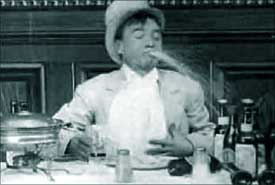 Nowadays there's scarsely a soul who remembers the days when "must have been the Welsh rarebit" was used to explain why someone had a bad dream, as in Harle Oren Cummins' collection of short horror tales with illustrations, Welsh Rarebit Tales (1902). Nowadays there's scarsely a soul who remembers the days when "must have been the Welsh rarebit" was used to explain why someone had a bad dream, as in Harle Oren Cummins' collection of short horror tales with illustrations, Welsh Rarebit Tales (1902).
Indeed fewer & fewer would even know that the rarebit is a cheese fondu & not a rabbit from Wales. At any rate, a title like Dream of a Rarebit Fiend (1906) promised, in its day, a nightmare experience.
The music with the dvd release is contempoary to the Edison Company film, having been provided by an Edison cylandar player & performed by the Edison Military Band.
The tale opens with our hungry dandy (Jack Brown) in a top hat in a restaurant gobbling down rarebit with relish, not that it had any actual relish on it, getting it all over his face. He's also, by the by, drinking quite heavily, & in the vernacular of the day "must've been the rarebit" was a drunkard's excuse for the delirium tremons.
Staggering home "drunk" on the rarebit, a storm comes up blowing a steeple left & right. He climbs the steeple & clings to it for dear life. Finding his way home at last he toddles off to bed, & is soon dreaming of the rarebit fondu pot, out of which tiny demons climb.
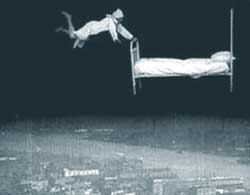 Then the sleeper's bed begins dancing about the room before it leaps out the window flying off through the night. Then the sleeper's bed begins dancing about the room before it leaps out the window flying off through the night.
Our sleeper appears to awaken & nearly falls from the flying bed, but grabs hold of the foot of the bed holding on for as long as he can. When at last he falls, he is caught on spinning weather vein & spins about until his britches rip & he falls out of the his bed onto the floor of his room, just like Little Nemo.
If it is looking an awful lot like a sequence out of the comic strip Little Nemo in Slumberland, that's because the script for this little Eddison film is by Little Nemo's creator Winsor McCay, who also created the less well known comic strip,Dreams of a Rarebit Fiend.
A pioneer work of live-action animation, the Dream of a Rarebit Fiend remains highly amusing & odd as all hell. McCay took a great interest in animation & would later film his own Rarebit Fiend episodes as part live action & part animated drawings.
Douglas Fairbanks makes an appearance in When The Clouds Roll By (Food-Induced Nightmare) (1919), in overt imitation of Dreams of a Rarebit Fiend. Doug plays Daniel Boone Brown of New York who has eaten onions at midnight, giving him an upset tummy. We see the onion as a man in an onion costume dancing about in Daniel's belly.
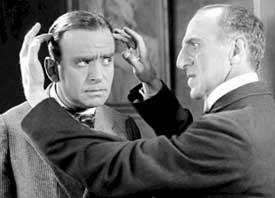 Daniel next eats a piece of lobster, which manifests in his stomach as a whole lobster doing backflips. Next is roast rarebit cheese on toast. It manifests in the tummy as a fellow in a weird blobby costume. All these foods play ring-around-the-rosies as Daniel suffers. Daniel next eats a piece of lobster, which manifests in his stomach as a whole lobster doing backflips. Next is roast rarebit cheese on toast. It manifests in the tummy as a fellow in a weird blobby costume. All these foods play ring-around-the-rosies as Daniel suffers.
Last is Mince Pie, so now a guy in a pie-slice costume joins the antics in the belly. Off to bed he toddles, not knowing his valet who served the food, in cahoots with Dr. Mitz across the hall, have planned this late-night meal in order to induce Daniel's nightmares, for the sake of the bad doctor's obscure research.
His dreams include a ghostly burly man in rags; fingers dripping from the ceiling or growing from furniture; showing up in his pyjamas at a party attended by beautiful women; falling in a pool; being chased by the guys in the food costumes from his belly; & walking up a wall & onto the ceiling, & down the opposite wall.
These events take grand advantage of Douglas Fairbanks' physicality. For close, he falls down a chimney & awakens beside his bed.
In McCay's own animated short Dreams of a Rarebit Fiend: Bug Vaudeville (1921) a tramp is given some leftover Welsh rarebit. That night he dreams of a vaudeville act put on by acrobatic insects.
In Dreams of a Rarebit Fiend: The Flying House (aka, Watch Your House, 1921) a woman has some rarebit at a party & returns home to her bed, dreaming that her husband constructs huge wings for either side of their house, puts a propeller in the front, & flies them around the moon. By this means they have escaped their creditors, though it ends badly when they are blown out of the sky.
In Dreams of a Rarebit Fiend: The Pet (aka, The Last Word; or, The Monster Dog, 1921), a man has some rarebit & that night dreams he & his wife obtain a small strange animal that begins to eat everything in sight, including their furniture.
The Pet grows to humongous proortions, & begins devouring the entire city -- yummy trolly cars, tasty buildings, everything. It's hard to imagine this didn't in some way influence King Kong (1933), especially as The Pet also tussles with biplane bombers.
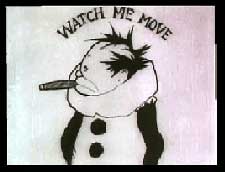 Winsor McCay called himself the inventor of animation. That's a considerable exaggeration, since animators such as Emile Cole not only preceded him in the art of moving drawings, but earlier animated films already had miniature stories to tell, though in 1911 with his very first personally animated piece, Winsor thought the novelty of motion was sufficient & didn't bother to tell a story. Winsor McCay called himself the inventor of animation. That's a considerable exaggeration, since animators such as Emile Cole not only preceded him in the art of moving drawings, but earlier animated films already had miniature stories to tell, though in 1911 with his very first personally animated piece, Winsor thought the novelty of motion was sufficient & didn't bother to tell a story.
Even so, Winsor was certainly he was a signal pioneer. Most of his little films are quite primitive & certainly not on the level of genius as his classic newspaper comic strip about the adventures of Little Nemo in Slumberland. But anyone who loves Slumberland will find many lesser things to like in McCay's short films.
The very first film he directed incorporating his own art was Little Nemo (1911) which is the shortened title for a piece variously shown as Winsor McCay the Famous Cartoonist of the N.Y. Herald & His Moving Comics; Winsor McCay Explains His Moving Cartoons to John Budy; Winsor McCay Makes His Cartoons Move; or Winsor McCay & his Animated Comics, for Winsor went on the Vaudeville circuit to lecture & promote himself while interacting with his Moving Comics.
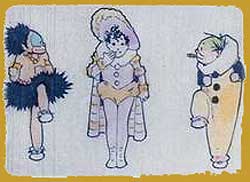 Because the animated Little Nemo was not really intended to stand alone as a story of interest, but only as a centerpiece to his vaudevilel act, there's not much to it. In the film per se, Winsor appears & begins to draw characters from his comic strip, which momentarily spring to "life." Because the animated Little Nemo was not really intended to stand alone as a story of interest, but only as a centerpiece to his vaudevilel act, there's not much to it. In the film per se, Winsor appears & begins to draw characters from his comic strip, which momentarily spring to "life."
Some interesting tricks of perspective & some fun-house mirror style stretching occurs. And that's it.
The live action bits in this as in most of Winsor's films come off as padding, because he did all the production drawings himself & it took him aeons to draw enough of them for even a short-short piece of animation. This one took 4,000 individual drawings; his second film would take 8,000 individual drawings.
In the live action portions of Little Nemo it purports to reveal part of Winsor's work method. It actually does no such thing but it does at least show that Winsor drew his characters in their entirety in one go, needing no penciling beforehand.
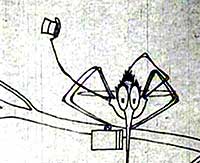 How a Mosquito Operates (aka, The Hungry Mosquito, The Story of a Mosquito, or Winsor McCay & His Jersey Skeeters, 1912) was a great leap forward for Winsor because he actually gets the animation to tell a story.
How a Mosquito Operates (aka, The Hungry Mosquito, The Story of a Mosquito, or Winsor McCay & His Jersey Skeeters, 1912) was a great leap forward for Winsor because he actually gets the animation to tell a story.
Why he didn't think of that with Little Nemo the year before is a bit of a puzzle. The story is actually from one of his Dreams of a Rarebit Fiend comic strips, but not identified as such in the cartoon.
Simple drawings of the environment are quite lovely, given from the persective of a mosquito with hat & satchel, seeking his meal. A sleeping bald man is handy. The skeeter lands & prepares for a happy meal. What proceeds is an absolutely wonderful piece of animation, & Winsor gets a lot of character out of his skeeter.
Sinking of the Lusitania (1918) is Winsor's one earnest serious & "realistic" cartoon. There is once more some live action padding, with McCay putting in a personal appearance. There follows a report of the sinking of the Lusitania with a semi-realistic bit of animation of the sinking ship & drowning victims, with political text-cards thrown in.
It doesn't have a lot of impact because it relies on public sentiment of the day which demonized the Germans for sinking an ocean liner full of civillians during a time of war (no one cared that the Lusitania was in fact transporting arms in its hold).
Winsor was so angered by this event of 1915 that he wasted the next couple years animating it for whoever was still interested in old news in 1918. It's really quite a shame because his animation career was already winding down.
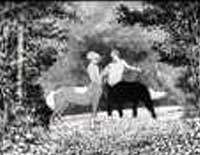 Centaurs (1918-1922) was not released in Winsor's lifetime. Its a Beardsleyesque fantasy of male & female woodland centaurs. It's pretty but really there's not much to it. Centaurs (1918-1922) was not released in Winsor's lifetime. Its a Beardsleyesque fantasy of male & female woodland centaurs. It's pretty but really there's not much to it.
Another unreleased fragment is Gertie On Tour (1918-1921) which privdes an addition to McCay's most famous cartoon Gertie the Dinosaur (1914), mixing it up thematically with Dreams of a Rarebit Fiend: The Pet (1921) as Gertie like The Pet has a run-in with a trolley car. The best bit is Gertie dreaming of a world of dinosaurs.
Flip's Circus (1918-1921) is incomplete & likewise uneleased. It gives us bits with a Little Nemo character, Flip, sticking his head in the mouth of a hippo-like baby Wiffinpoof. Trivial but cute.
While animators on two continents were making great leaps forward, Winsor was still just sitting there by himself drawing his characters one after another, convinced that making drawings move was sufficient to captivate audiences. It's no wonder that he was unable to finish several of his works, & continued even through the Rarebit films in 1921 to pad out his animation with live action.
Though on his lecture circuit he insisted on his own importance in this new art form, Winsor really can't be regarded as one of the great early animators, though he can never be denied his gigantic position among newspaper comics artists.
Many of these cartoons have been available in several formats over the last years, but Winsor McCay: The Master Edition (2002) includes all his short films. There is also a commentary track for the whole set provided by John Canemaker. Some of McCay's silent cartoons are frankly boring enough that it's nice to have the softly spoken commentary turned on to spice up the experience.
There's addionally a stills gallery made up mostly from Canemaker's collection, which moves foward automatically & can't be speeded up though it's moving at the speed of growing grass. And lastly is Canemaker's minor but informative little memoir Remembering Winsor McCay (1976) which rounds off the collection nicely.
copyright © by Paghat the Ratgirl
|
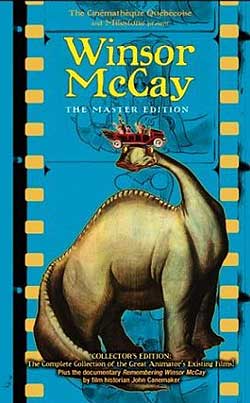

 Then the sleeper's bed begins dancing about the room before it leaps out the window flying off through the night.
Then the sleeper's bed begins dancing about the room before it leaps out the window flying off through the night. Daniel next eats a piece of lobster, which manifests in his stomach as a whole lobster doing backflips. Next is roast rarebit cheese on toast. It manifests in the tummy as a fellow in a weird blobby costume. All these foods play ring-around-the-rosies as Daniel suffers.
Daniel next eats a piece of lobster, which manifests in his stomach as a whole lobster doing backflips. Next is roast rarebit cheese on toast. It manifests in the tummy as a fellow in a weird blobby costume. All these foods play ring-around-the-rosies as Daniel suffers.
 Because the animated Little Nemo was not really intended to stand alone as a story of interest, but only as a centerpiece to his vaudevilel act, there's not much to it. In the film per se, Winsor appears & begins to draw characters from his comic strip, which momentarily spring to "life."
Because the animated Little Nemo was not really intended to stand alone as a story of interest, but only as a centerpiece to his vaudevilel act, there's not much to it. In the film per se, Winsor appears & begins to draw characters from his comic strip, which momentarily spring to "life."
